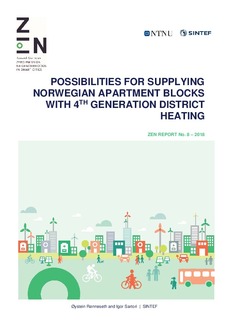| dc.description.abstract | This report is a part of Work Package 4 Energy Flexible Neighbourhoods. The goal for WP 4 is to develop knowledge, technologies and solutions for design and operation of energy flexible neighbourhoods.
4th generation district heating is evaluated as a sustainable solution for covering the heating demand in Zero Emission Neighbourhoods and reducing the strain on the electricity grid. There are, however, some technical challenges that must be solved before it is introduced. One of them is to determine how low the supply temperature could be in different building types, which again will determine the minimum district heating supply temperature. This report is evaluating the minimum supply temperature in Norwegian apartment blocks based on effects of improving the thermal envelope and reducing the temperature levels for the heating system. The analysis is based on building simulation and focuses on whether the reduced supply temperature guarantees the comfort in the building, considering the coldest room with a heating setpoint of 22 °C and a minimum acceptable indoor temperature of 19,0 °C.
The simulated buildings are based on the data available from the IEE project Tabula. Generic models representative for Norwegian apartment blocks have been developed in IDA ICE. They consist of eight age classes and three levels of energy performance:
• Prior to 1956, from 1956-1970, 1971-1980, 1981-1990, 1991-2000, 2001-2010, 2011-2020 and 2020 →.
• Original, intermediate renovation and standard renovation
For the intermediate renovation level, it is only the windows and infiltration rates that have been changed. Tabula also includes an ambitious renovation, but this has not been modelled as the results are expected to be similar to those for the newest age class. Simulations are performed with two different dimensioning temperature levels for the radiators typical for Norwegian buildings; 80/60 and 60/40 °C.
The results showed that it is possible to reduce the supply temperature to the radiators from 80 to 60 °C for buildings from 1971-80 and all newer age classes, even for the non-renovated buildings. This is based on a minimum acceptable indoor temperature of 19.0 °C (according to the Norwegian building regulations, TEK). For the older age classes, an acceptable indoor temperature is not achieved for the non-renovated buildings when reducing the supply temperature. Although it is sufficient to perform the intermediate renovation to maintain temperatures above 19 °C, it is highly recommended to perform the standard renovation for these age classes to reduce the number of hours with a significantly reduced indoor temperature compared to the setpoint temperature. In addition to reduce the heating demand and thus lead to energy savings, this will also ensure that the occupants are satisfied with their thermal environment. It is important to note that the conclusions would be different if the minimum acceptable temperature was set higher, for instance at 20 or 21 °C.
The results can be used by district heating companies, building owners, contractors and consulting companies in order to evaluate the introduction of 4th generation district heating in Norwegian apartment blocks. Both the models and excel sheets with hourly results are available for partners and researchers within FME ZEN | |
